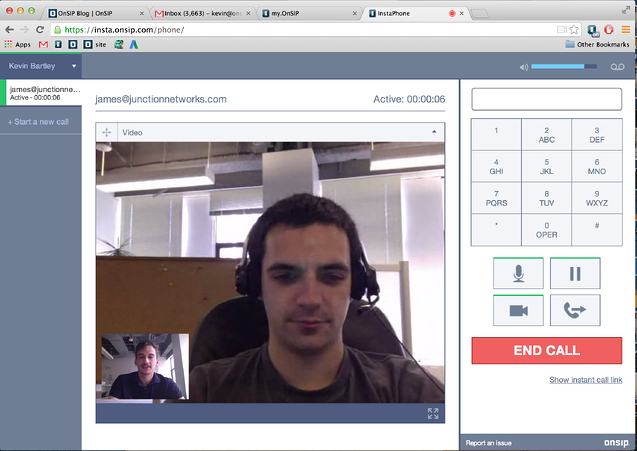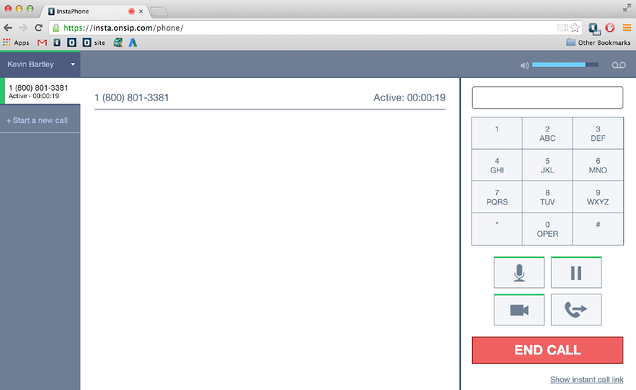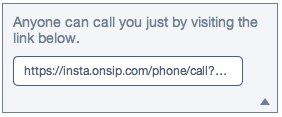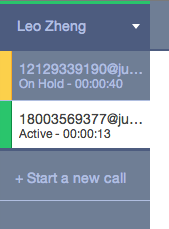As we recently discussed on our blog, the boundaries between hosted PBX services (traditionally anchored by desk phones) and other OTT real-time communications services are quickly being redrawn by WebRTC. Hosted PBX staples such as the ability to answer work calls from home, video conference into a meeting room, and IM with coworkers have traditionally required desktop software clients, downloadable browser plugins, and/or conferencing equipment. Today, these capabilities are implementable in browser applications built with Web Real-Time Communications (WebRTC), opening new doors for applications that cater to remote working.

InstaPhone blurs the lines between hosted PBX and OTT real-time communications
The idea offers particular advantages to the country's burgeoning mobile workforce. According to Global Workplace Analytics, over 4 million people work away from the office on a daily basis. When the metric is changed to people who work from home in any capacity, the number balloons to 1/5 of the workforce (30 million people), a figure that has increased almost 80% since 2005. This has given workers unprecedented leeway in their work situation, but it also creates new technical challenges for those who want to remain productive, integrated, and fully functional members of the company.

InstaPhone can make VoIP and PSTN calls directly within the browser
We made early moves at OnSIP to adopt WebRTC in our hosted PBX offering with OnSIP InstaPhone, a web VoIP phone capable of receiving video calls and real-time caller data. Requiring no plugins or additional software, InstaPhone gives teleworkers the freedom to connect to their business phone system, extension dial, call the PSTN, manage multiple calls, login to a queue, and transfer calls directly within their internet browser. Our team uses it all the time.
"I use InstaPhone a lot, typically when working from home or at a conference," commented OnSIP VP of Marketing and Product Management Nicole Hayward. "It's nice to have my work phone at my finger tips and on-demand. It works well on my Chromebook and matches my work style - I live in web apps like Basecamp, Google Drive, Google Calendar, LightHouse, and GMail, so InstaPhone makes it official: My Chromebook is like a portable home office."


"The fact that InstaPhone uses WebRTC should be unnoticeable to users," said OnSIP Lead Developer Will Mitchell. "The goal with any phone, whether it be in a web app, a VoIP softphone, or a regular landline telephone, is that it should be simple and seamless to use. InstaPhone achieves this solution by offering a traditional telephone interface, along with the ease and portability of a simple webpage. It can actually serve as a complete replacement for teleworkers or hosted PBX customers who want to move away from desk phones."
InstaPhone was engineered using WebRTC capabilities built into Chrome and Firefox. WebRTC is comprised of three HTML5 APIs that allow developers to treat streaming voice and video input like JavaScript objects. We ended up building The OnSIP Network, our own fully integrated SIP-based signaling platform (which is now open to developers), atop our hosted PBX offering to power WebRTC on InstaPhone. By utilizing our pre-existing SIP infrastructure, our engineers were able to craft a web VoIP phone that can traverse NATs and firewalls, bridge compatibility gaps between endpoints, and call the Public Switch Telephone Network via SIP interconnects.
"SIP is the perfect option for WebRTC signaling, and it gave us more technical leeway in crafting InstaPhone" said OnSIP Software Engineer James Criscuolo. "As a proven, open standard, SIP has shown its versatility and reliability for carrying information since the advent of the modern internet. Now we've repurposed the SIP architecture of our hosted PBX platform to take advantage of the robust WebRTC signaling capabilities it can offer. InstaPhone also takes advantage of SIP's unique PSTN interop abilities to give users a fully functioning VoIP phone within the browser itself."
Teleworking has never been so prevalent in the United States, and with easier ways to communicate, it is sure to grow in the coming years. WebRTC gives developers the power to engineer hosted PBX functionality directly into the browser, and InstaPhone is the first example of what a browser-based phone system can do. So give InstaPhone a shot! Visit https://insta.onsip.com/phone/ and sign up for a 30-day free trial OnSIP account if you're not already a customer. See what it's like to have a phone at your fingertips without requiring physical cords, extraneous software, or a presence at the office.

